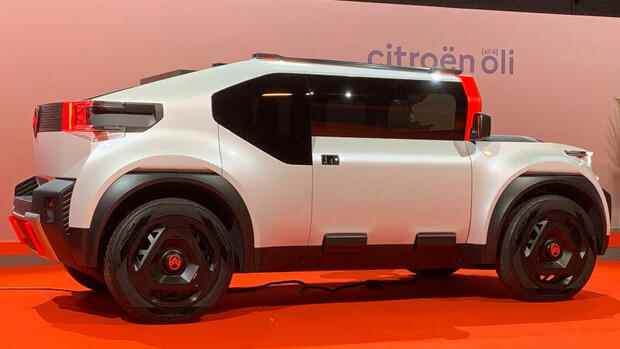Cologne A car manufacturer with an attached junkyard? At Stellantis, this is not absurd, but forward-looking – and is called circular economy. By 2030, the new “Circular Economy” business unit is expected to generate sales of two billion euros. The aim is to maximize the lifespan of vehicles and spare parts. The Group wants to consistently return materials and old vehicles to the production cycle so that new vehicles and products can be created from them.
In 2023, Stellantis will open a “Circular Economy Center” at the Mirafiori site in Italy to dismantle vehicles and refurbish spare parts for renewed use. Revenue from recycled materials and parts is expected to increase tenfold compared to 2021. At the end of September, Stellantis presented the design study Citroën Oli, an e-car made of cardboard – a sign of where the journey is headed.
Reusing valuable resources – this order of the day will also be an important topic at the world climate conference in Sharm el-Sheikh from Sunday. Large parts of the industry take the growing importance of secondary materials seriously. At last year’s climate conference in Glasgow, BMW presented the “i Vision Circular”, a concept car that was made almost entirely from recycled material. On average, BMW already puts the proportion of recycled materials in all of its vehicles at 30 percent, and the goal is 50 percent. “It’s also about business sustainability,” says BMW CEO Oliver Zipse, referring to raw material prices.
According to figures from the auditing company EY, the much-cited circular economy is only just beginning. According to EY, only 8.6 percent of the global material flow is recycled. But the pressure to act has reached the executive floors. According to a survey by the consulting firm Staufen, 84 percent of German machine builders fear being pushed out of the market if they don’t succeed in the green transition.
Top jobs of the day
Find the best jobs now and
be notified by email.
The crux: With the rethinking of environmental issues, not only the sources of supply change. “With the intended circular economy, new business models are emerging for machine builders that still have to prove themselves,” says Sarah Brückner, Managing Director for waste and recycling technology in the Association of German Machine and Plant Construction (VDMA). Which model carries depends on the functionalities and product properties in each individual case. “There is no one-size-fits-all approach,” says Brückner.
The VDMA sees nine fields of action within the circular economy – including “Recycling”, “Repair” or “Reduce”. “Pay per use” is also a conceivable model for more efficient use of machines and systems. A manufacturer no longer sells machines, but makes them available to customers – payment is made per workpiece. Both sides would have efficiency advantages, says Brückner. Manufacturers retain access and can thus more easily convert, maintain and adapt machines to new production methods. The machine stays in operation longer, says Brückner.
“By conserving resources in this way, companies become less dependent on volatile commodity markets.” Pay per use takes away the investment risk for customers, which is a great advantage in uncertain times. The Munich management consultancy Kaufmann/Langhans sees pay per use in industry “on the rise”. According to the results of a current study, 69 percent of mechanical and plant engineering companies in German-speaking countries are familiar with the flexible payment model, and a good quarter use it.
The commitment and optimism of researchers is also growing when it comes to a kind of “perpetuum mobile” for products and materials. “From the linear economy, where waste was always produced at the end of the process, to recycling, which shaped our thinking for almost 50 years, we have arrived at the true circular economy,” says Julia Krause, Professor of Industrial Procurement at the HTW Dresden.
The Wuppertal Institute sees no alternative: “The transition to a resource-saving circular economy is an indispensable prerequisite for industrial climate neutrality and the industrial transformation to sustainability,” writes transformation researcher Stephan Ramesohl. In short: no climate protection without resource protection. And digitization is a key to this.
Data makes recycling easier
This also applies to the central component of electric vehicles – the battery. A consortium from science and industry wants to increase their recyclability via a digital product passport. “The more life cycle data of a machine or product is known, the more flexible it is to repair or convert it, and the easier it is to recycle parts,” says Susanne Kadner, head of the circular economy initiative at Acatech. The German Academy for Engineering Sciences is one of the ten consortium partners.
The goal is the seamless digital documentation of a battery life. From 2027, the EU will require the quantity of recovered materials to be specified for industrial and traction batteries. The consortium also wants to systematically determine where the raw materials used come from and how much effort it takes to recycle a battery. The first results are announced for spring. “We determine which data points are important in terms of a circular economy,” says Kadner.
The automation company Festo from Esslingen is also geared towards the circular economy – using nature as a model. “There is no waste and no waste there, we just have to learn to transfer these principles to our business,” says Festo boss Oliver Jung. Words are followed by deeds. In a bioreactor, Festo wants to produce new materials that go beyond petroleum chemistry and, together with research partners, are working with algae, says Elias Knubben, Vice President Corporate Research and Innovation.
During metabolism, the algae produce fatty acids, color pigments and surfactants – and thus bio-based starting material for food or plastics that are biodegradable and climate-neutrally recyclable, explains Knubben. Festo is looking for partners from industry to scale up the project. “We get a very good echo,” says Knubben.
More: Battery production backwards – How Cylib wants to solve the raw material problem of electric car manufacturers
